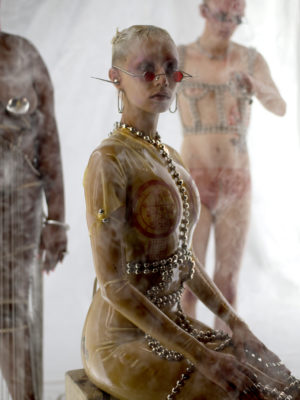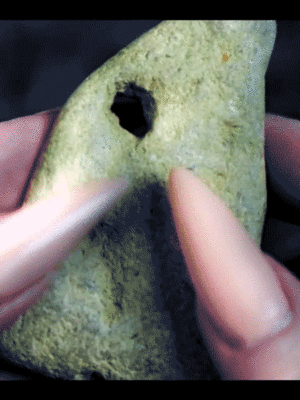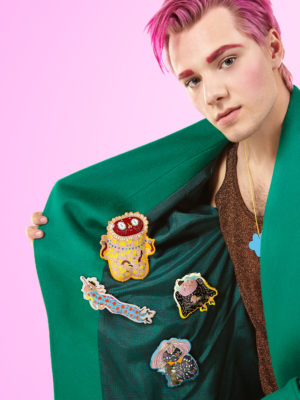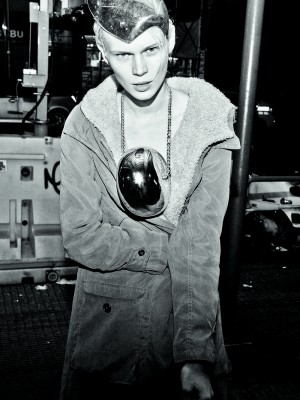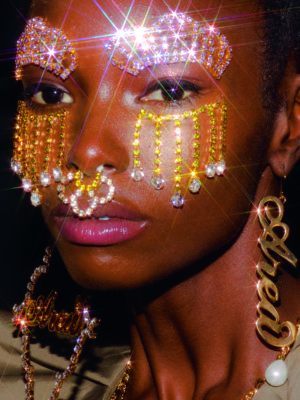
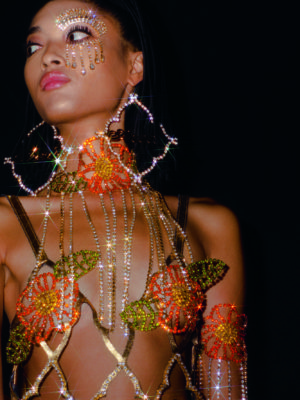
Like some kind of futuristic chainmail, metal chains were strung together and draped over the bodies of models to form imaginative bikini tops, dresses, head coverings, and bodices with diverging levels of grunge and glam.
___STEADY_PAYWALL___
Unlike Versace, with its iconic metallic dresses, designers of a new generation are not seeking to manipulate metal into behaving like textile. Instead, they are embracing the most archetypal forms of jewelry and molding them to the body in new and unexpected ways to create the looks seen strutting down the runway. In response to an age defined by image saturation, the exploitation of self-expression, and new business systems on digital platforms, these designers are proposing amplified forms of jewelry as tools of survival and resistance as well as conduits of personal style.
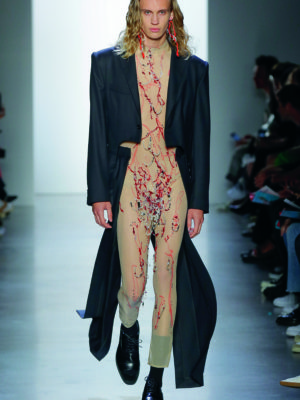
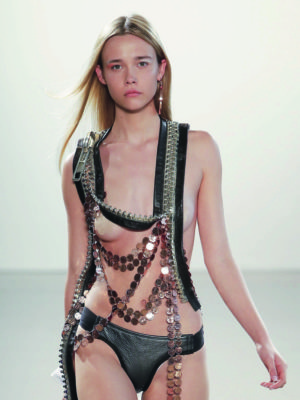
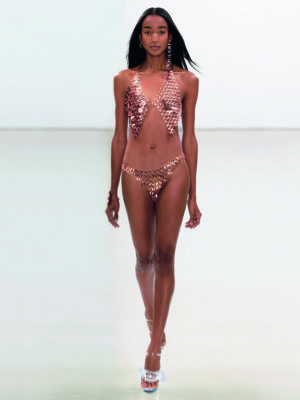
New York-based designer duo Beckett Fogg and Piotrek Pansczczyk — the founders of AREA — have incorporated jewelry on an increasingly large scale within their designs since their collection for Fall 2018, reaching maximum exposure in their latest presentation for Spring 2020. Jewelry was not simply worn, but fully embodied in this fantasy-filled collection, which included suits, matching sets, and dresses embellished with an abundance of multilingual nameplate body chains, crystal-encrusted trellis bras, dresses, capes, and pants that snaked over bare skin. Most dramatic of all were the gold chain epaulets and petticoats. Jewelry as garment took center stage as the glimmering chains swayed down the catwalk, their prismatic crystals reflecting the flashing lights, look after look. The brand sought to break boundaries and be a unifying force with the multiculturalism of their casting and the many languages used in their name plate embellishments. Additionally, some looks featured crystal “beard” masks and crystal waterfalls or petals around the eyes. The former alluding to androgyny, and the latter being the most augmented version of a widely popular trend seen throughout Fashion Week: rhinestone make-up.
The rhinestone is having a big moment thanks to the elaborate designs of make-up artist Doniella Davy (@donni.davy) — seen in the instant cult classic HBO show Euphoria. In fact a search for #euphoriamakeup yields over 37,000 posts on Instagram. As Gen Z is starting to come into its own, establishing the trends that will define it in future years, the rhinestone is put forth as a birthstone for this generation. Recalling the shimmering allure of performance costumes by Bob Mackie as well as Britney Spears’ iconic body suit in the music video for “Toxic”, the rhinestone is incredibly accessible and without the pretension of precious stones. Euphoria features model-turned-actress Hunter Schaffer, who recently donned AREA’s golden petticoat and eye jewelry for Vogue’s digital platforms to recap the “the best” of Fashion Week. AREA’s take on jewelry as garment is ultimately optimistic and idealistic, but also verges on narcissistic; it reflects the flashy aesthetic favored by many of the rich and famous variety, usually in the form of the iced-out grills and chains that have filtered down to the masses digitally. But at the same time, it is a strong indication of the potential of jewelry as a significant part of self-expression, especially when the rules of fashion are broken.
“As Gen Z is starting to come into its own, establishing the trends that will define it in future years, the rhinestone is put forth as a birthstone for this generation.”
Reacting directly to digital culture, and in particular case to its negative aspects, the jewelry designer Chris Habana — a veteran of Fashion Week runways who has collaborated with fashion brands like Gypsy Sport — unveiled his latest collection in partnership with the adult website Cam 4, featuring steel chain and ball tops, masks, and bustiers among other jewelry-garment hybrids. The collection was created in direct response to the censorship that has been encroaching on the digital space of many in the art, fashion, and sex industries as a result of the Fight Online Sex Trafficking Act (FOSTA) and Stop Enabling Sex Traffickers Act (SESTA). The websites and Instagram accounts of legitimate businesses or individuals connected to the sex industry are being shut down, which is affecting the livelihoods of many. Habana himself had his Instagram temporarily deleted just the day before this collaboration was presented, further validating the inspiration for the collection and providing fodder for a show meant to combat the invisible powers attempting to silence voices like his own. The designer wanted to create looks that highlighted the very things that were being censored, such as nipples, for which metal plates and rings were designed. And the aforementioned chain and ball outfit was made to be a hard-edged layer to the naked body underneath —all in unapologetic celebration of “free the nipple.” These are also appropriate representations of Habana’s overall “feeling yourself” attitude, which goes hand in hand with the current culture of body positivity and efforts to celebrate diversity and inclusivity. “The term jewelry can be very limiting because it immediately sends images of engagement rings, dainty earrings, and such,” says Habana. “I think there’s so much more that can be made out of ’jewelry‘ when it is rethought and can transform itself into hardware and body and face adornments. I think metal accessories and accents can complete an outfit, but when properly done, can be the ENTIRE look altogether.” He hopes to further explore the fusion of metal in garments in the future.
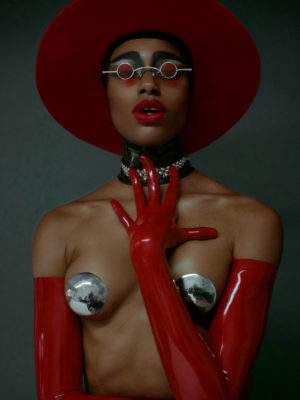

“I think there’s so much more that can be made out of ‘jewelry’ when it is rethought and can transform itself into hardware and body and face adornments.”
Whether pretty or punk, jewelry made a lasting statement during this past Fashion Week. AREA and Habana are just two examples from an emergent generation of designers that stars, among others, fashion favorites like Creepyyeha and also includes emerging artists like Jimin Lee, Kota Okuda, and Tashiann Yasmine. They too expand on the previously defined limits of both jewelry and fashion, and engage with the concerns of an increasingly digitally driven world. Creepyyeha, run by designer duo Yeha Leung and Alejandro Lafontant, is the go-to atelier for custom couture “bondage/fetish” clothing, favored by performers such as Kali Uchis and Naomi Smalls. Although usually made of sleek plastics or leather with hardware accents, their designs have also gone beyond these materials to include pearl bras and skirts, as well as delicate crystal chains over clear plastic sets or rhinestone-encrusted illusion body suits, à la Britney Spears. Much like Habana’s collection, Creepyyeha seeks to put the body and exuberant sensuality at the forefront, working towards the celebration and normalization of this aesthetic on public platforms.
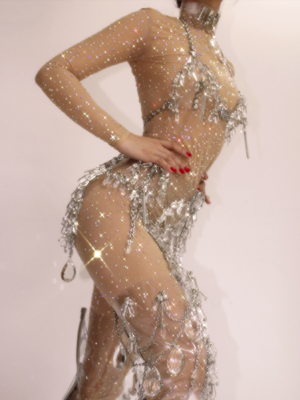
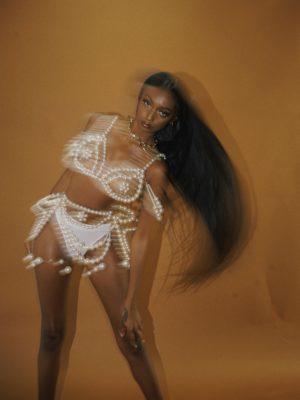
This season, Lee, a recent graduate of Parsons, designed a collection of innovatively androgynous men’s suits combining classic shapes with see-through mesh sections patterned with elaborate beaded chains. The beads stand out viscerally against the bare body in shades of red, orange, and silver, bejeweling the wearer’s vulnerable skin. Okuda, proclaimed jewelry designer entering the realm of fashion, released a line inspired by US currency that included literal interpretations such as large-scale dollar bill and money-clip dresses, as well as bikinis made of pierced pennies, which left bare skin peeking through the silhouettes of Abraham Lincoln. Tashiann Yasmine, a fresh face on the fashion scene—her Spring 2020 collection being only her second one—herself describes her designs as armor for women. Tops made out of chains, pearls, plastic pendants, and crystals are quickly becoming characteristic of her work of which she says, “I create so women are free to express themselves however they please while wearing my designs and feeling sexy, confident, and fearless while doing so.”
The elements of their carefully crafted jewelry-garments and these pieces’ interactions with the body provide insight into new, hybrid possibilities —and together they argue that jewelry’s potential as a tool for self-expression has not reached its full capacity. Call it chainmail for the future — with these sensual and playful pieces, meant to engage and celebrate the body, we can gear up for the biggest battles on the digital landscape today: being seen and heard.
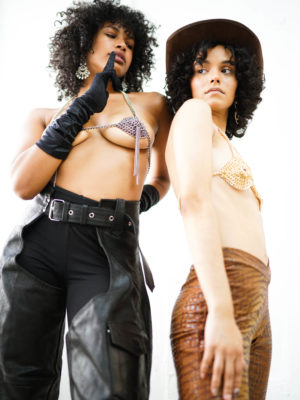
Angelik Vizcarrondo-Laboy is a New York-based curator, writer, and arts administrator focusing on contemporary art and craft. She is the Assistant Manager of Curatorial Affairs at the Museum of Arts and Design (MAD), New York and a 2020 Curatorial Fellow at the Center for Craft, Asheville. She holds an MA from the Bard Graduate Center, New York, in Decorative Arts, Design History & Material Culture.
This article is published in the 2019 New York City Jewelry Week Paper, the result of a collaboration between Current Obsession and NYCJW.
